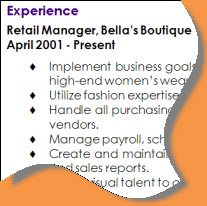
Resume Writing
Employment History
Introduction

The reason a hiring manager looks at your resume is to see if your skills and experience are a match for his open position. Where does he look on your resume? He looks at your Employment History to see if the skills and accomplishments you list show that you will be an ideal worker.
In this lesson, you will learn which format is best for listing your employment history. You will learn how to market your resume by focusing your history on accomplishments and measures rather than simply listing duties. Then you will craft an employment history for your own resume.
Employment history
The No. 1 reason employers are looking at your resume is to find out if your skills and experience match their needs. How do they know what skills and experience you've had, and how can they tell if you will be an asset to their organization? By reading your employment history section.
You want this section to be powerful and to represent you in the best possible light. However, it also must be clear, concise, and understandable to anyone who reads it.
How can you make your Employment History powerful and concise?
Click the buttons in the interactive below to learn more about the various employment history formats. Visit the Resume Gallery to see a full view of the bookkeeper, experienced paralegal, and teacher sample resumes used in these interactives.
You try it!
 < />
< />Open your My Resume document to complete this activity. Enter your own information into this document as we progress through each part of the lesson. Begin by following the instructions below.
You will be working only in the Experience portion of the document for this activity. Please refer to the following picture:

Replace the template text with your own information. Be sure to remove the brackets as you are replacing text.
- Rename this section, if desired, depending on the focus you are trying to achieve. Some suggested titles include:
- Employment History : If you are trying to show a steady stream of past jobs
- Experience: If you are trying to emphasize the skills you used previously
- Skills: If you want to focus on your skills that transfer to the job you want
- Beginning with the section highlighted with the orange box on the picture above, enter your most recent employment information:
- Replace [Month, Year] to [Month, Year] with the dates of your current or most recent employment.
- Enter your employer's company name in the [Company Name] placeholder.
- Type the city and state abbreviation for the location where you worked in the [City, ST] placeholder.
- Replace [Job Title] with the job title you have or had when you left this job. Make sure it is a title that is understandable to anyone who might read your resume. For example, OHC Specialist might be better explained as Claims Specialist, Occupational Health.
- Describe the job by replacing each [Description of work accomplishment or duty with measure] with a brief description of an accomplishment or job duty you had in this role. Be sure to include a measure of some sort so a hiring manager will have a more concrete idea of the scope of your experience. For example, instead of saying that as a cashier you balanced the cash drawer, explain that you regularly balanced the cash drawer with less than 1% margin of error.
- Repeat step one for each additional job you have held. Add or delete sections as needed.
- Save the file on your computer. You will be adding more information as you progress through the following lessons.
Remember that you want each job title or description to reinforce the points you included with your summary, profile, or objective statement.
The template shown above is for a resume in the chronological format. If you have chosen to use the functional or combination format instead, you may consider searching for a resume template in the proper format. You may also try modifying this template if you are familiar with Microsoft Word. You can reformat this section to highlight your skill sets, broken into functional categories, along with a brief description of how you have used these skills in the past.